Defining criminal law
Farmer (2008) argues that there are two main approaches to defining criminal law. The first approach is that criminal law is made up of behaviours which can be seen as moral wrongs against the community (e.g. Duff 2007), or behaviours for which it is the community’s job to punish and which deserve the powerful response of a criminal conviction (Lamond 2007). The first problem with this view is that 21st-century criminal law extends beyond behaviours which the public agree should be considered crimes (like murder and rape) to include behaviours which are less obviously morally wrong, such as using a mobile phone while driving. The second problem with this view is that it assumes a strong consensus in society about what is and is not morally wrong – a consensus that is not present in modern societies like England today (Wilson 2012). This does not mean that criminal law never reflects public morality – only that we cannot fully explain modern criminal law using moral beliefs (cf. Devlin 1965).
The harm principle is an alternative approach to the idea of criminal law reflecting community values. The harm principle argues that criminal law does, and should, target behaviour that causes physical harm, psychological harm, or serious offence to another person (Feinberg 1984). As with the morality approach to law, one problem with the harm principle is that it cannot explain everything that criminal law currently defines as a crime. The harm principle seemingly cannot explain what Ashworth (2008) calls the preventive function of criminal law – the law’s labelling certain kinds of behaviour as carrying a risk of social harm or danger and therefore deserving of public condemnation and punishment. Nor can the harm principle explain the increasing number of regulatory offences within criminal law. One example is entering into an arrangement with someone you have reasonable cause to believe is under age 16, where the arrangement gives that person the chance of winning an animal as a prize (Animal Welfare Act 2006, s.11(3)). This does not mean that we should assume that criminal law never regulates behaviour that is objectively harmful (Hall and Winlow 2015: 89). However, criminal law’s scope is so wide that it is now difficult to see which types of behaviour are most harmful to society simply by looking at criminal law. A final problem with the harm principle is that it is vague and does not give any guidance about how to weigh the seriousness of different kinds of harm, how to judge them, or how to balance them (Harcourt 1999: 193). Some critical criminologists, for example Pemberton (2015), take a very different view of harm as a trigger for social response, but their ideas about harm do not come from the law itself. Instead, Pemberton and others take a wider approach to defining social harm based on harmful events that prevent humans from flourishing and which are the product of human action or inaction (Yar 2012: 63). These harms can be damaging to physical or mental health, damaging to a person’s autonomy, or relational (i.e. about social exclusion or discrimination), but are preventable through political and economic decisions about social conditions and are often the direct result of capitalist political economies (Pemberton 2015: 9–10). On this view, harm goes far beyond what criminal law would define as harmful, to include issues such as poverty, racism, and social exclusion (ibid.).
The second definition of substantive criminal law, drawing on the work of Williams (1955), is that it is simply the part of the law that deals with behaviour defined as criminal, and results in punishment by the State when a person is found guilty of breaking the law. In other words, criminal law is different from other kinds of law (like civil law, which deals with other forms of behaviour that result in some form of compensation after a finding of guilt) because it uses a different procedure to respond to people who break it. Criminal law accepts that it is fragmented and diverse in nature. However, it uses the criminal justice process to impose consistency and objectivity on itself and to present an image of itself to society as being consistent and objective (Farmer 1996). This hides the reality that criminal law is not as objective or standardised as it presents itself to be (Norrie 2014). In fact, criminal law has a range of functions. Some of these functions are instrumental, such as the idea of the rule of law discussed next; some are ideological, such as the prioritising of the interests of the powerful in society over those of the powerless (Lacey 1993). The following chapters of this book identify these functions, as criminal law and criminal justice are analysed as part of the same social process of criminalisation (Lacey and Zedner 2017), or regulating bad or risky behaviours.
